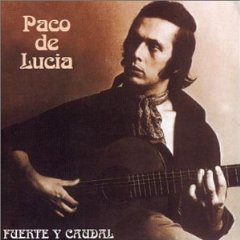Paco De Lucía - Fuente y Caudal (1973)
Paco De Lucía - Fuente y Caudal (1973)

1. Entre dos aguas (Rumba) (6:01)
2. Aires choqueros (Fandangos de Huelva) (4:16)
3. Reflejo de luna (Granaína) (3:54)
4. Solera (Bulerías por soleá) (3:43)
5. Fuente y caudal (Tarantas) (5:13)
6. Cepa andaluza (Bulerías) (5:48)
7. Los Pinares (Tangos) (3:35)
8. Plaza de San Juan (Alegrías) (3:11)
Paco de Lucía - Flamenco guitar Ramón de Algeciras - Flamenco guitar
By the time "FUENTE Y CAUDAL" was released in 1973, 25 year old Paco de Lucia was clearly acknowledged as the world's premier flamenco guitarist, a position not relinquished in the 30 years that have followed. The album could also be regarded quite fairly as Paco's first truly great recording.
"FUENTE Y CAUDAL" is most renowned for the opening "rumba" titled "Entre Dos Aguas". This is the tune that transformed Paco from a flamenco hero to a ( Spanish ) national hero, its intense and expressive character a unique inspiration ( far from the "light" rumba flamenca that had been played before ) that influenced countless numbers of flamenco musicians. For the first time on record, Paco plays in an ensemble ( 2nd guitar, electric bass and congas ) that was at that time unusual in flamenco music. True to the (actually double) meaning in its title, "Entre Dos Aguas" has roots in two different but nonetheless compatible musical realms.
The remainder of the album is wonderful but more traditional, consisting either of solo pieces or those using conventional accompaniment. Two cuts in particular stand out. "Fuente Y Caudal" ( a piece in the "taranta" form ) is dark and mournful, one of Paco's most profound creations ( it never fails to send chills up the spine ). The other standout is "Cepa Andaluza", in the "buleria" style which Paco himself has described as the most complex and characteristic flamenco form. "Cepa Andaluza" is explosive, as Paco plays with volcanic energy accompanied "por fiesta" by flamencos using "palmas" and "jaleos" ( handclaps and shouts of encouragement ). This cut practically jumps out of the speaker!
One can explain Paco de Lucia's legendary status by pointing out specifics: 1) Phenomenal technical proficiency ( lightning "picado" scales, ferocious "rasgueado" and "pulgado" strumming, fluid left hand chord positioning and a flawless sense of rhythm ) 2) Compositional talent ( longer stretches of melody, new chordal progressions that still sound "flamenco" ) 3) An adventurous spirit ( collaborating with jazz musicians; investigating Brazilian music ) 4) A wise and contemplative nature ( coupled with intense love and zeal for flamenco music and culture )
But a more basic, earthy and truly "flamenco" explanation would simply point out that Paco possesses an abundance of "duende"; the ability to summon up the profound and seemingly inexpressible and communicate it to others. There are quite a few moments of Paco's "duende" heard on "FUENTE Y CAUDAL", which is unreservedly recommended to all lovers of great music. ---Ian K. Hughes, amazon.com
download: uploaded yandex 4shared mediafire solidfiles mega gett filecloudio nornar ziddu
Zmieniony (Czwartek, 27 Luty 2014 14:54)








